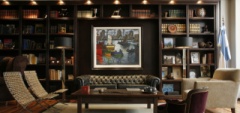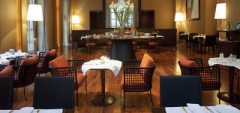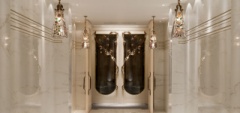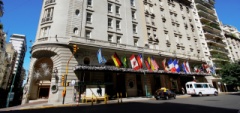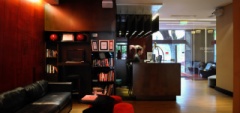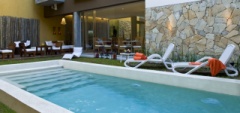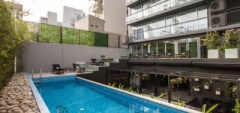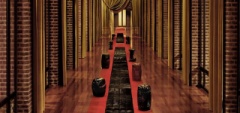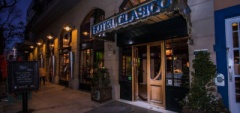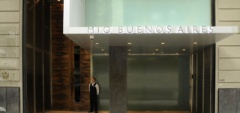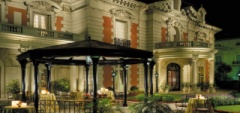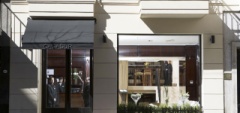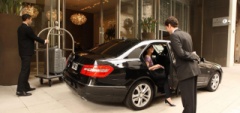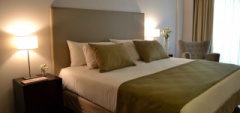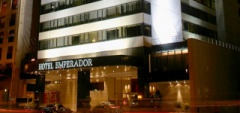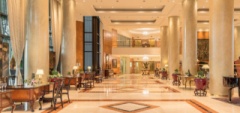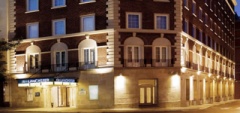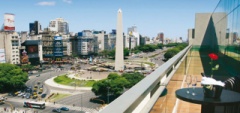Buenos Aires activities
In a city as varied and cosmopolitan, this is just the tip of the iceberg
With its facinating mix of cultural and economic influences, the capital city of Buenos Aires has an activity to suit any palate. From art tours, to ancient sewers, traditional dances to walking through ornate gardens, there is definitely something for everyone here. Below we have outlined a few of our favourite trips from over the years, please see what you think.
Buenos Aires Art Tour
This superb little tour shows off some of the impressive museums in the city and features some of the most important South American artists of the 19th and 20th centuries. During the three hour tour you will be guided through a selection of the 57 musuems that Buenos Aires is home to and given a expert’s view on how they compare to some of Europe’s greatest such as Rubens, Manet, Cezanne and Renoir.
Buenos Aires offers a broad choice of opportunities to enjoy its artistic heritage; its 57 museums house permanent and visiting collections of classical and contemporary art. “ART in BA” tour is guided by art historians and includes a careful selection of the most representative works and collections on display at the moment. Two museums and a contemporary Art Gallery will be included in the tour. Following are descriptions of some of the museums that may be visited in this 3 hours long afternoon tour.
MALBA (MUSEUM OF LATIN AMERICAN ART IN BUENOS AIRES)
Eduardo Constantini, entrepreneur and avid art collector,opened his museum in an airy and luminous purpose-built structure in September 2001 with a display of over 200 works by 20th century modern and contemporary artists collected from all over Latin America. The permanent collection includes works by Fernando Botero, Pedro Figari, Antonio Segui, Antonio Berni, Diego Rivera and Frida Kahlo and is complemented by temporary exhibitions.
NATIONAL MUSEUM OF FINE ARTS
The museum contains approximately 11,000 paintings, sculptures, tapestries, engravings, drawings and objects. The exceptional collections of Argentine art include works by the founders (Morel, García del Molino), the 19th century masters (Pueyrredón, De la Cárcova, Sívori, etc.), early 20th century artists (Fader, Pettoruti, Xul Solar, Vitullo) and contemporary artists. The museum’s permanent collection is varied, with works by El Greco, Rubens, Tiepolo, Zurbarán and Goya, among others. Nineteenth-century French painting is thoroughly represented, with works by Manet, Cézanne, Renoir, Rodin and others. There are also works by 19th-century and early 20th-century Spanish artists, including Genaro Pérez de Villaamil and Ignacio Zuloaga. Temporary exhibits allow the museum to display works by celebrated contemporary artists from around the world.
Note: The National Museum of Fine arts is closed on Mondays and the Museum of Latin American Art closes on Tuesdays. During those days these museums are replaced by optional Galleries and/or Museums.
The Collection Fortabat
This stunning private collection is the life’s work of the feted businesswoman and philanthropist, Amalia Lacroze de Forbat. Only recently opened to the general public the collection in housed in a 6,000 square meter building designed by renowned architect, Rafael Vinoly. This tour is truly a rare opportunity to see an amalgamation 0of different styles and periods together in one place.
The Colleción Fortabat was inaugurated in Buenos Aires on October 22, 2008 welcoming visitors to view the private collection of Maria Amalia Lacroze de Fortabat in a 6,000-square meter building designed by renowned architect Rafael Viñoly. The collection includes works spanning the art history of Argentina through the 1980s, but also works by artists such as Rodin, Turner, and Warhol. The private collection that has gone public (Ms. Fortabat does not like calling it a museum) hosts approximately 230 paintings and sculptures selected by a team of curators.
The building is a long rectangle aligned with the waterfront behind it. Made of concrete, steel, and glass it offers two exhibition halls, a library, an auditorium, and a cafe-restaurant overlooking the river. The roof is made up of a system of 15 louvered panels that are mounted on the exterior of the glass vault and control the penetration of light into the galleries. Each panel comprises a series of blades featuring an internal aluminum structure, external aluminum cladding and custom made supports on rolling pads to achieve the desired displacement along the arch. Ms. Fortabat always wanted to see her works of art and the stars simultaneously... this is how she achieved it. The computer controlled panels can be automatically positioned to open the gallery to the sky, shade it from direct sun light or to obtain different lightning.
The collection includes paintings by Berni,Van Gogh,Warhol,Prilidiano Pueyrredón,Paul Gaughin, Ernesto Deira, Rómulo Macció, Xul Solar, Emilio Pettoruti, Marta Minujín, Fernando Fader, Nicolás García Uriburu, among others. One of the highlights is Gauguin's ''Tahitian Women Near the Palms,'' which Ms. Fortabat bought for $18 million at Sotheby's in 1980.
ABOUT AMALIA LACROZE DE FORTABAT: Mrs. Amalia Lacroze de Fortabat is an important Argentine businesswoman and philanthropist.
Her foundation, Fundacion Amalia Lacroze de Fortabat, has given more than $40 million to numerous charitable organizations throughout Argentina since 1971.
Hidden Buenos Aires
We all know that the city that we see as inhabitants and the city that is seen by a tourist are two very different things and, quite often, we would argue that the city of the inhabitant is the true heart of the place. Well….we agree! This great little tour has been designed to take in a few of the lesser known sites and sounds of the city, casting an eye into some of the neighbourhoods that have played an important part in the capital’s history but that have been forgotten over the years.
An unconventional tour visits some of the “forgotten” neighbourhoods in the city that do not belong to tourist circuits and which - nevertheless - tell amazing stories and boast beautiful buildings. Barracas, Nueva Pompeya, Parque Patricios and Boedo are the urban grounds of old factories, street murals, secret societies, working class project-housings, remarkable churches, parks, bridges, traditional bars and significant people. As a journey that sheds light both on the past and present of the working class sectors, this tour rediscovers in the city’s historical script the leading parts of workers, immigrants, tramways, railroads, tango and soccer.
The tour visits the following sites: Masonic logia house, Hipólito Irigoyen Station(1st Stop), Barracas, Lanín passageway (2nd Stop), Florentino Ameghino park, Parque Patricios and Nueva Pompeya districts, Nuestra Sra. de Pompeya Church (3rd Stop), Alsina bridge, Boedo Avenue (4th Stop), Margot and Manzi cafes.
Jewish Buenos Aires
Argentina is the second largest nation in Latin America and boasts the largest Jewish community in the region, mostly concentrated in Buenos Aires. Specialists guide this comprehensive tour that introduces guests to the Buenos Aires Jewish culture. We explore the traditional Jewish neighbourhood, “Once” (pronounced on-say). Similar to New York's Lower East Side story, once the Jewish community here prospered most non-Orthodox Jews emigrated to more attractive barrios.
Nevertheless, Once still houses an active Jewish community and references an important historical centre for it as it is home to the AMIA (Asociación Mutual Israelita Argentina, the main Jewish –Ashkenazi- Community Center), several synagogues, and most of the kosher dining offered in the city. One of Once’s well known synagogues is Yesod Hadat, founded in 1932 by Jews from Aleppo, Syria. At Once, you will find any amount of wholesale shops, primarily selling fabric, buttons, paper-goods, and cheap-quality clothing. Strong national security at all Jewish institutions are the result of measures taken following the 1994 bombing of the AMIA building. The new AMIA building continues to serve as a centre for an array of cultural and community events and gatherings. A beautiful statue by renowned Israeli artist, Agam, stands in the courtyard paying tribute to the 85 victims of the bombing.
The Tour visits Argentina’s oldest synagogue, Congregación Israelita de la Republica Argentina, known as "Libertad" (as it lies on Libertad Street). The temple houses a small Jewish museum, with a good collection of photographs and Jewish ritual objects. In the Recoleta District, the tour stops at a park where the former Israeli Embassy stood. Here, twenty three trees represent the lives which were taken in a terrorist attack in 1992.
Other important stops in the tour are: the Institute of Jewish Studies and outstanding Ashkenazi and Sephardic temples
La Boca District
Buenos Aires is a city of plazas and parks, a city of open spaces where the porteños love to walk, meet for coffee and browse among the stalls of the markets that are always present on weekends in the larger squares. This tour visits the open-air art market at the colourful Caminito Street in La Boca, followed by a light lunch at a typical La Boca Bodegón (Canteen).
The tour goes to La Boca, a picturesque district of Buenos Aires which sits on the river mouth of the Riachuelo as it joins the estuary of the River Plate –hence its name, boca = mouth. Caminito, “que el tiempo ha borrado, que juntos un día nos viste pasar,” Caminito, worn away by time, which once saw us passing by together (1926, lyrics by Garbino Corría Peñaloza, music by Juan de Dios Filiberto).
This is where the famous Caminito Street lies, scarcely 100 metres long, yet very much an emblematic post-card of the city. Designed by the Italian-Argentine artist Benito Quinquela Martín at a disused rail port terminal just beyond the iron cantilevered Puente de la Boca which bridges the river, it is a short yet busy pedestrian alley of brightly-painted houses which cluster above the cobblestones. The sheets of corrugated-iron shimmer with glossy blues, reds, yellows and greens and recall the original colours of the leftover paint with which the dockworkers painted their homes in the 19th century. Below these precarious structures, a man in a trilby hat and a white silk scarf knotted around his neck intones one of the best-known of all tangos, Caminito, as his fingers rhythmically knead the bandoneon, originally the Genovese version of the accordion. Perhaps there will also be a couple of dancers clasped together, lost in the intricately subtle moves that the music demands...
While in surrounding streets you can buy souvenirs to suit all tastes, in the Caminito street itself there are a number of good oils and watercolours for sale, painted by local artists and depicting classic scenes from Buenos Aires life as well as more abstract forms of art. Expect to bargain for these, for not
only is the conversation that stems from this a national pastime, it is also considered to be good manners.
The tour ends with lunch at La Barrica, facing Caminito and enjoying traditional dishes and a round of drinks. Tango dancers usually entertain at La Barrica where food arrives on bright table mats. The menu includes beef, empanadas (turn-over pies), fish, cheese platters and pastas.
Mataderos Fair
The famous Sunday fair at Mataderos, just outside the city, is a fascinating glimpse of life in Argentina as it has been for generations. Traditionally the fair was a cattle show and often featured many of the workers and farmhands that came in from the Pampas to show off their skills on horseback. Today there is a far more relaxed feel to the whole affair, but it is still a great chance to see some of Argentina’s history come to life.
The traditional Sunday Fair at Mataderos represents Argentina’s cultural roots. Born in 1986, it includes arts and crafts and regional foods (empanadas, home-made wine, locro - corn stew and tortas fritas – sweet fried pastry). There is also a small music and dance festival with dancers performing the gato, chacarera, and other folk dances. The sale-stands at the Fair are placed in the shade of aged tipa trees, surrounding the monument to the Resero (herdsman) across the still-operative Cattle Market. Artisans offer handicrafts made from silver, wood and ceramics. At Mataderos visitors can witness skilled demonstrations of horsemanship and gaucho traditions as well as tango. One of the gaucho games, the Corrida de la Sortija, involves spearing a small ring hanging loosely from a pole while at full gallop.
In addition, there are traditional games for adults and children, like sapo (trying to introduce a coin from a distance through the open mouth of metal toad) and carrera de embolsados (sack race).
Hours: From April until the end of November on Sundays and Holidays from 11 a.m. to 8 p.m.
Palermo Parks and Bike
Once you have ventured out from your hotel and taken a first look at Buenos Aires you shall soon want to explore the different city neighbourhoods that offer numerous contrasts and endless sights to see. A wonderful alternative to find your way around is taking a guided tour on a bicycle! Anyone who can ride a bike can take part.
Bilingual tour guides are on hand to assist visitors and provide helmets, child seats, rain gear, medical assistance, a mineral water and bicycles of course! Buenos Aires is a city that has many parks. The Parque Tres de Febrero has nearly 200 acres of lawns, copses, lakes, and trails, but is more like a patchwork-quilt of smaller parks including El Rosedal (the rose garden). The entire area is known locally as Los Bosques de Palermo. Rich grass and shady trees make this urban oasis a favourite for both joggers and nature lovers.
The Bike Tour of the Palermo Parks lasts approximately 3 1⁄2 hours. There are bike paths in some areas and in others the preferable route to follow avoids heavy traffic streets. Once all riders have assembled, the tour takes off into the heart of the posh Recoleta district. It then continues to Palermo to visit the ‘Rosedal’ rose-garden, the renowned Polo Fields of Palermo, where the Argentine Open Polo Championship takes place in November every year, offering the world’s best polo matches. Across the street is another well-known city landmark, the ‘Hipódromo’ - Palermo’s horse-race course. The ride takes us to the parkland woods and lakes as well as cycling through Barrio Parque, the beautiful residential area with tree-lined streets and magnificent homes and embassies.
This tour-on-wheels allows visitors to enjoy a close-up view of the surroundings while riding a bike quite effortlessly as Buenos Aires offers an extra bonus to cyclists – its roads are mostly flat so no uphill struggles, just a bit of healthy exercise!
Palermo Soho Walk and Shop
Truly a city to be enjoyed on foot, Buenos Aires offers keen walkers, window-shoppers and people-watchers wide leafy avenues and narrow side-streets, lined with shops selling everything from leather and fur coats to dulce de leche (milk jelly) and chocolate alfajor biscuits, interspersed with cafés which honour the Latin custom of meeting for a coffee at any time of day.
Palermo Viejo is probably the best known of the new hip enclaves in Buenos Aires and one of the city’s most lively barrios, or neighbourhoods. Built in the early 20th century, this area is lined with old houses that today serve as homes, restaurants and eclectic boutiques. The neighbourhood has been divided into sub-divisions suitably named Palermo Soho and Palermo Hollywood.
Palermo Hollywood owes it name to the TV and radio production companies that opened offices in the area. Once these companies settled, bars and nightclubs followed and nowadays the area is best known for its ecletic offer of restaurants, nightclubs and coffee shops. Palermo Soho bears a striking resemblance to its New York and London counterparts. But beneath the ever-expanding roster of boutiques, sidewalk coffee stores, and the trendy restaurants, beats a distinctively South American heart, one that has turned this area into the destination for both cutting-edge designers and traditional artisans.
Spread around the Plaza Serrano (officially Plazoleta Cortázar) this new fashionable area for design, restaurants, bars and street culture was formerly a strictly bohemian location. It blossomed into a thriving, hip neighbourhood thanks to the designers who set up their shops here. The traditional low houses have been adapted into boutiques and bars, creating a bohemian feel. At the centre of it all the Plaza Serrano hosts a wonderful and busy fair on weekends, where some local artisans and hippies hang out and sell their goods. Anything from homemade mustard to souvenirs and ornaments can be found here.
Tigre and the deltas
Just 32 Kilometers north of the Obelisk, the town of Tigre takes its name from the yaguarete, the south American tiger or wildcat which haunted the dense tropical forests, preying upon the livestock and children of the first settlers and the “guarani” native Indians. This tour will take you on a guided tour of both the town itself and the famous waterways that run out through the delta.
The Tigre, the river on which the town now lies, was originally a small and insignificant stream until severe flooding in 1820 swept away the small fishing community of Las Conchas and created a new watercourse with a deep riverbed. The port which soon sprang up along its shores welcomed vessels of all sizes which shipped wood and fruit down to Buenos Aires. Towards the late 1800s, the town started to develop its tourist potential that has increased steadily over the decades. From the boatyards to the elaborate rowing clubhouses constructed by the different immigrant populations in the 19th century, the Belle Epoque left its mark with the ornate architectural style of the period, endowing the town with an eclectic and fun personality, reminiscent of the first holiday makers and their European ways.
One of the town’s main attractions is the Fruit Market, a complex of stalls, galleries and stands which swarm over the quays, a magnet for tourists and shoppers keen to sample the wares of the craftsmen from the many neighbouring islands; wickerwork baskets, exotic plants and flowers; furniture carved from local wood; home made candles, honey and oils; a mouth watering array of fruit from kakis and passion fruit to every imaginable variety of citrus.
The Riverside
A delightful way of spending the day is to take a boat ride through the waterways, an experience that can only be described as a mixture of the Thames and the Amazon. Weekend houses of imposing grandeur, white stuccoed fronts and manicured lawns lie among the palm trees on one island, neighbour to another where untidy wooden structures perch on stilts and platforms under which play rages, brown skinned children. English cottages stand next to Italian villas, azure-painted shacks and run-down boathouses while through the water glide skiffs, canoes and barges.
The Program
Drive up to Tigre through the gracious old-world suburbs of Olivos, San Isidro and San Fernando where the wealthier classes reside, past the Tudor-style mansions near squares lined with little French cafes and Italian ice-cream parlours. At Tigre, visit the Fruit Market.
From here it is a short drive to the pier where the long wooden launches depart for different islands on the delta, carrying schoolchildren, visitors, weekend home owners and sometimes even chickens or other farmyard animals. The launches chug past luxury yachts and the market barges carrying all kind of provisions as well as dredgers and fishing canoes, allowing for a unique glimpse into life on the river.
Colonia
Colonia del Sacramento, in Uruguay, was the only Portuguese settlement along the Rio de la Plata. Founded as Nova Colonia do Sacramento in 1680, for years it operated as a contraband port, escaping the rules imposed on trade by the Spanish crown settled in the capital city of Montevideo. This superb day tour will give you the opportunity to take a look around this small town and soak up the atmosphere.
Today this 17th Century town is a charming cobble stoned gem, a fast ferry-ride across the Rio de la Plata from Buenos Aires. Built with Portuguese style houses and cobblestone streets, the historic quarter of Colonia or Barrío Historico on a small peninsula jutting out into the river is reminiscent of old Lisbon. It was named a Unesco world heritage site in 1995.
The tour leaves your Hotel in Buenos Aires at 8.00 a.m. towards the port to sail an hour across the River Plate. Once in Colonia get ready to walk and discover the history and culture hidden in every corner. Lunch will be served at a local restaurant. In the afternoon you will be guided to museums before bordering the coastline towards the Real de San Carlos where the Plaza de Toros or bulls ring lies. Built in 1910, it gave place to 8 bullfights only before bullfighting was prohibited in 1912. Before heading back to Buenos Aires you will be given free time wonder around, shop for handicrafts and relax!
Recoleta walking tour
Enjoy a two hour walk in the close surrounding areas of your Hotel. You will visit the posh Recoleta neighbourhood, named after the religious order which had it’s monastery there, the neighbourhood is associated principally with the Pilar Church and the magnificent Cemetery. There is, however, a great deal more to this area. Besides being the most elegant residential district in Buenos Aires, Recoleta is also an important nexus of culture, dining out and café-bar society.
There are also scores of shops, from the predictable haute couture “maisons” on Avenida Alvear to hippie stalls and the latest in interior design.
Recoleta was late to develop as a neighbourhood as upper-class Porteños chose, until the 1860s, to live in the area then known as Catedral al Sur (today, San Telmo). It took a yellow fever epidemic in 1871, coupled with the 1860 opening of a tram service, to encourage the movement of the elite towards the northern suburbs. The clean slate of a new district allowed planners to furnish Recoleta with parks, drinking water and buildings of architectural interest. From the 1880 ́s onwards, Recoleta became a place of French-style chateaux and plazas. When the Prince of Wales visited in 1925, a special commemorative pamphlet described the area as “aristocratic, polished, artistic and magnificently beautiful”.
Even today, with hotels, towers, shopping centres and weekend rabble nudging their way between the old palaces and pathways, the neighbourhood retains a civic grandeur and European orderliness which is rare elsewhere in the city. People lucky enough to live near the cemetery enjoy access to a connecting patchwork of plazas and to the only public place aside from the major parks where cars do not pollute the land and air.
The walk includes the Paseo del Pilar, Buenos Aires Design, The Centro Cultural Recoleta, Hippie Fair (weekends are the best days) ending at the renowned Recoleta Cemetery.
Three markets
Buenos Aires is a city of plazas and parks, a city of open spaces where the porteños love to walk, meet for coffee and browse among the stalls of the markets that are always to be found on weekends in the larger squares. We suggest making a day of three very different open-air markets: the art market at the colourful Caminito street in La Boca, followed by a browse among the antique stalls of San Telmo and finishing with a stroll around the stands of handicraft articles in the sloping gardens of the Recoleta.
La Boca
Start your tour on a Sunday morning in La Boca, a picturesque district of Buenos Aires which sits on the river mouth of the Riachuelo as it joins the estuary of the River Plate –hence its name, boca = mouth.
Caminito, “que el tiempo ha borrado, que juntos un día nos viste pasar,” Caminito, worn away by time, which once saw us passing by together (1926, lyrics by Garbino Corría Peñaloza, music by Juan de Dios Filiberto).
This is where the famous Caminito Street lies, scarcely 100 metres long, yet very much an emblematic post-card of the city. Designed by the Italian-Argentine artist Benito Quinquela Martín at a disused rail port terminal just beyond the iron cantilevered Puente de la Boca which bridges the river, it is a short yet busy pedestrian alley of brightly-painted houses which cluster above the cobblestones. The sheets of corrugated-iron shimmer with glossy blues, reds, yellows and greens and recall the original colours of the leftover paint with which the dockworkers painted their homes in the 19th century. Below these precarious structures, a man in a trilby hat and a white silk scarf knotted around his neck intones one of the best-known of all tangos,
Caminito, as his fingers rhythmically knead the bandoneon, originally the Genovese version of the accordion. Perhaps there will also be a couple of dancers clasped together, lost in the intricately subtle moves that the music demands... While in surrounding streets you can buy souvenirs to suit all tastes, in the Caminito street itself there are a number of good oils and watercolours for sale, painted by local artists and depicting classic scenes from Buenos Aires life as well as more abstract forms of art. Expect to bargain for these, for not only is the conversation that stems from this a national pastime, it is also considered to be good manners.
San Telmo
From La Boca go to the celebrated antiques market in the old district of San Telmo, whose narrow cobbled streets and colonial architecture conjure up the essence of Buenos Aires a hundred years ago. The fair is held every Sunday from late morning until late afternoon in Plaza Dorrego, a large raised square packed with stalls selling anything from beer coasters, old magazines and other curious knick-knacks to crystal goblets, chandeliers and Victorian gold jewellery. Once again, the bargaining proviso holds in good stead.
In the surrounding streets, performance artists sing and dance tango, hold puppet shows and pose for interminable periods of time as living statues. Behind them, entrances to art galleries and yet more antique and curiosity shops invite you in to finger worn chamois gloves, admire marble statues and pore over postcards of Buenos Aires in the 1950s.
La Recoleta
Continuing northwards, it is probably time to head to the Recoleta district for a cup of tea at La Biela on the corner of Presidente Quintana Street and the pedestrian esplanade of R. M. Ortiz. This is one of the best places from which to people-watch, seated outside on the esplanade under the vast leafy shade of the ancient gum trees. At weekends, the gardens of the surrounding Plaza Francia, styled on the Parisian Bois de Boulogne, are host to hundreds of stands selling handcrafted wood, alpaca or horn mates; tapestries and belts embroidered with native Indian designs; silver-set rings, pendants and other jewellery of green and white onyx or rodocrosite, the pink-veined quartz typical of the north; leather-tooled belts and bags; the ingeniously hand-carved masks and animals from the northwest, and much more.
Argentina education
This tour is designed to explore, discuss and understand the most important characteristics of the Argentine educational system while visiting three of its architectural landmarks in the city of Buenos Aires. The tour is approximately four hours long and includes a handout that focuses on its highlights.
The three stops to visit are:
- Colegio Nacional de Buenos Aires: an imposing building housing one of Argentina’s most prestigious public secondary schools.
- The University of Buenos Aires’ (UBA) School of Medicine or its School of Economic Sciences.
- The UBA’s main campus (Ciudad Universitaria). Throughout the tour, we will talk about the specific places that we visit and cover topics related
to education in Argentina, including:
Origins and history of the present Argentine educational system. Special emphasis is placed on the role of the educational system in creating a national identity at the end of the 19th and early 20th centuries when millions of European immigrants arrived in Argentina.
Current state of primary and secondary education in Argentina with reference to its role, main problems and challenges. Both public and private educational systems are compared and the most relevant differences are discussed. The importance of religious education in Argentina is examined and finally, the future of primary and secondary education in the country is analysed together with the role that it plays in social mobility and equal opportunities for all citizens.
Main characteristics of tertiary education in Argentina. The particular case of the University of Buenos Aires, the largest public university in Argentina with more than 300,000 students trying to work their way through a university with no entrance examination, no tuition fees, governed by professors and both former and current students. We shall also briefly examine the fascinating relationship between universities and politics and the main problems and challenges that Argentine tertiary education faces. Finally, we will try to address the question of whether the country’s higher education system should aim at responding to the needs of the labour market.
At the end, we shall have a picture of what the Argentine education system represents today and what it should strive to be in the future for the country to achieve academic and economic development.
These topics and stops are a suggestion based on what we consider can be of interest to the group. The contents, scope and stops of the tour can be modified and adapted to suit the group’s specific interests.
Architecture in Buenos Aires
With all of the many influences and long history that Buenos Aires has undergone, the city is a fascinating amalgamation of different styles of architecture. Quite often the capital followed the styles and designs that were prevalent in Europe at the time such as the Art Nouveau or the Art Deco periods. It does, however, also have a variety of influences that were borne out of necessity and the influence of the Spanish. This 3 hour tour visits many of the building of most note in the city.
Buenos Aires is an elegant agglomerate of many different architectural styles, a mirror of whatever trends and styles were in vogue in France, Germany, England or Spain for the last 150 years. While the centre of the city’s broad avenues pay homage to the influence of Baron Haussman’s Paris, the impressively ornate lines of Art Nouveau and Art Deco sweep up to Belle Epoque cupolas and Victorian Gothic facades at their most rigorous and detailed stand next to neo-classical palaces. Buenos Aires also boasts its own unique styles and housing according to the demands of the time they were built.
This 3-hour tour visits the National Parliament Palace, the Colon Theatre, the Banco Hipotecario (a jewel of brutalism) and the Kavanagh Building (a local combination of art deco and rationalism). Other buildings included in the tour are the Barolo Palace (inspired in the Divine Comedy), Retiro Central Train Station (an excellent model of railway architecture), and the more contemporary buildings in Puerto Madero.
Artist atelier tour
A very privileged glimpse into the private working lives of many of South America’s up and coming artists, a world which is rarely seen. This tour features three artists that have been chosen for their work and for the contrasts that their styles and subject matter have. At around 5 hours, it is a relaxing way to get to know a few Argentine artists and to also understand the mind of an artist a little bit more.
Artists’ Atelier Tour is an intimate four-hour journey around selected private art workshops covering several distinct genres, from painting to photography to…wait and see! This is a unique opportunity to meet both emerging and established local artists in the intimacy of their studios. A maximum of 10 guests participate in the tour and everyone is invited to ask questions, stand close to the works inspecting brushstrokes, to enjoy coffee and “medialunas” (pastries) and, of course, guests are invited to purchase artwork, but there is no pressure to buy.
The tour ends with a catered luncheon at a private gallery in the hip Palermo Soho district where guests can exchange their opinion on artworks and enjoy further pieces of art on display.
The main idea on Artists’ Atelier Tour is to bridge the gap between the artist and the audience, deepening the connection between them and offering an insider’s look at contemporary Argentine art.
Tour duration: approx 5 hours
Tango tour
Enjoy a typically Argentine first-class meal, be it the traditional steak, chicken or Patagonian lamb with a mouth watering array of salads as well as any number of excellent pasta dishes before settling down for a tango show which includes some of the best loved songs, music and dances performed by skilled musicians and dancers. To head to Buenos Aires and not see its most iconic dance is to miss out on a truly once in a lifetime experience.
The options for going to see live tango shows in the capital are fairly numerous and so it is worth having a chat with your consultant as to both budget, type of show and type of meal you are interested in.
On the whole, however, the general form for the evening is for you to be collected from your hotel in the evening at around 8 o’clock and to be driven to the tango venue. Here you will be offered a choice of menu with options for all of Argentina’s most famous dishes as mentioned above. For drinks, there will usually be a few options with champagne as a pleasant way to start things off and then followed by wines with the main courses.
After your meal the show usually commences and can take the form of a general display of the moves of the dance, or it can be more of a chance to learn and participate in the dance. This is more of an opportunity for people to have a go rather than being an official teaching period.
The evening ends at around midnight with drivers waiting to whisk you back to your hotel.
Bird watching at Otamendi Nature Reserve
Explore the largest and most important birding area in Buenos Aires, about a one hour drive from downtown: the Otamendi Nature Reserve, a significantly important national park that protects a massive system of grasslands, marshes, riverside forests, reed beds and shallow lagoons. A long road traverses the length of the marshes and guests will spend the day birding it from one end to the other.
An impressive diversity of species can be found at the reserve. Some of the possibilities guests might spot are: Common Snipe, Burrowing Owl, Field Flicker, Spectacled Tyrant, Great Pampa- finch and Scarlet-headed Blackbird, Sulphur-bearded Spinetail, Many-coloured Rush-tyrant and Long-tailed Reed-finch, Curve-billed and Straight-billed Reedhaunters. Water birds are also well represented, with many species of herons, Limpkin, Giant-wood Rail, and some ducks. In the open fields raptors such as Snail Kite, Long-winged Harrier and Aplomado Falcon are found.
Some of the summer (December to March) visitors at Otamendi include the Dark-billed and Ash-coloured Cuckoos, Yellow-browed Tyrant, Bran-coloured Flycatcher, Black-backed Water- Tyrant, Fork-tailed Flycatcher, Warbling Doradito and Masked Yellowthroat.
Hotel pick-up time: 05:30 Return to hotel: 19:30
Includes: Full day excursion with transportation, bilingual bird watching guide with telescope and tape recorder, entrance fees and box lunch with cold drinks.
Optional: The tour can be combined to with an afternoon visit to Costanera Sur, spending only the morning at Otamendi.
Buenos Aires by bike
The South and the North of the city: the best of Buenos Aires in one day. Start at Puerto Madero, a huge port project that was started at the end of the XIX century, but became obsolete, and after several years of abandonment, became the most modern and sophisticated district in the city. Riding around this neighbourhood you will find a different sort of park:” La Reserva Ecológica Costanera Sur" a wetlands and forest which forty years ago formed part of the river.
After sampling “mate” at the banks of the Río de la Plata, you will move on to La Bombonera, the Boca Jr soccer team’s stadium, and take a ride around “la Boca” neighbourhood, visiting the famous and artistic “caminito”, with its tango, painters and colourful “conventillos”. After that, you will go to the oldest area in Buenos Aires: San Telmo, the historic city centre where you will have a typical and "porteño" lunch. Riding across the “Microcentro”, the financial district, you will cycle from the South to the North of the city passing through the Retiro neighbourhood and on to Recoleta, an aristocratic area in Buenos Aires where you will visit the Recoleta Cemetery, with some of the most important characters in Argentina's history resting there. The tour ends with the biggest neighbourhood in Bs As; Palermo. This is the greenest area of the city, with rich architecture and expansive parks; a great place to be on two wheels. This is an unmissable tour that captures all of Buenos Aires in one day.
Graffiti and Street Art
Buenos Aires Street Art supports the local street art scene and its artists. Join a tour and find out why Buenos Aires is one of the street art capitals of the world. Explore different parts of the city with expert guides on the only street art tour that includes giant murals and visits neighborhoods that aren’t in the tourist guidebooks. Discover for yourself designs by more than 50 artists and the amazing stories behind their artworks.
Late night Milonga
In Buenos Aires there are many milongas – local clubs that bring people together to dance tango. Milongas have their secrets and this tour will help you discover them! Moving away from the standard tour and the main tourist areas, you'll delve into the city’s neighbourhoods where the most traditional and historic clubs are to be found.
Argentine cooking with Fernando Mayoral
The perfect tour for foodie fanatics, this is a chance to attend a private cooking demonstration and dinner in the house of acclaimed chef Fernando Mayoral. A successful career saw him cooking in some of the world’s best restaurants, including the three-starred Michel Bras in France, stints in Hong Kong and Brazil, and the Robert De Niro owned Rubicom in California, before returning to BA to open the much acclaimed Thymus. Disillusioned with the bureaucracy of restauranteering in Argentina, Fernando now prefers to share his wealth of knowledge in a more intimate and direct way – through private demonstrations and classes. Modern, creative Argentine cooking in a real Argentine home!
Typical Argentine Asado
This excellent small group tour was created to allow visitors to Buenos Aires the chance to enjoy a typical Argentine family asado. Your guide will take you to the butcher's shop, the veggie stall, the bakery, the wine store, all the while walking the cobblestone streets of Palermo Viejo and getting under the skin of this just like a local family would do. You then go back to a large private home and help prepare the asado. It is a first hand experience of learning how to prep the meat, create the salad, build the fire with charcoal and wood. The tour is an experience where you can learn about asado customs, and learn more information about the city in a very relaxed atmosphere. And you will be eating a fantastic asado guided by the very capable
hands of a master parrillero (local grill master). The tour runs from 10am to about 3pm, and the group size is limited to 10 but is normally
less, ensuring a personalised service & very enjoyable lunch!
Come Wine with Me
Your wine expert for this tour is an award winning food, wine and travel journalist, as well as a fully trained sommelier specialising in Argentine wines.
On this late afternoon tour, she invites you to visit her favourite wine bars and wine stores in Buenos Aires, where you can sample wares from around Argentina at three ports of call, learning as you taste. Choose from the following four themes for you tour, all will allow you to see past the usual big-winery suspects and discover some real gems to look out for next time you are ordering wine at a restaurant in Argentina:
1. The Argentina Tour – try different regions from Patagonia to Salta.
2. The White Album – Argentina also makes incredible whites.
3. I Love Malbec – terroir-driven tasting.
4. #NotMalbec – Big reds, no Malbec in sight.




